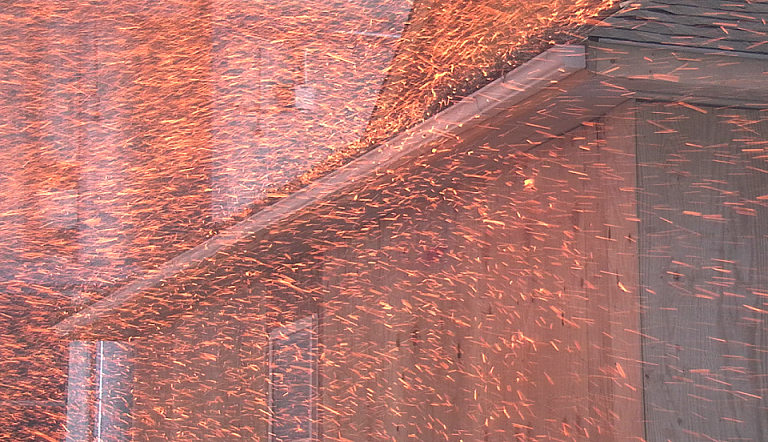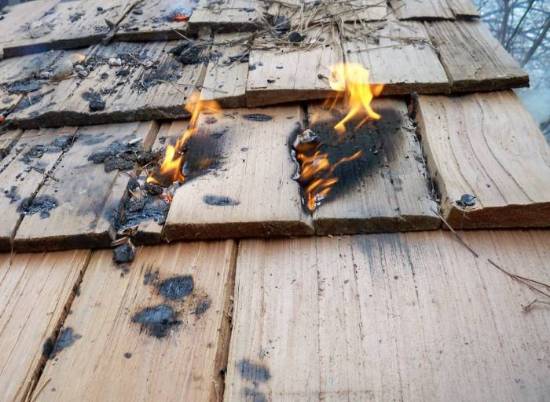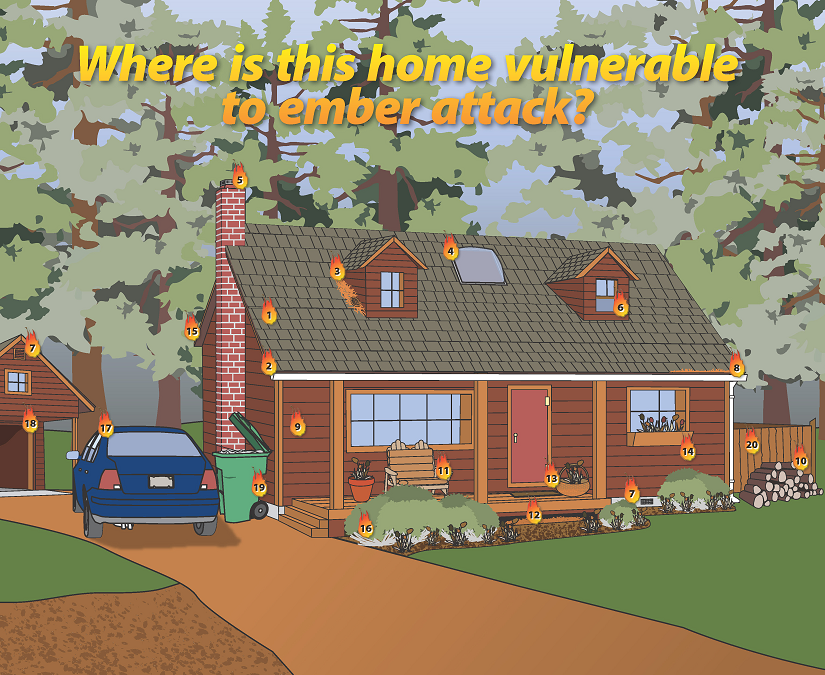036 - Protect Your Home from Wildfire: Ember Awareness Checklist
This fact sheet was adapted from Be Ember Aware! UNCE publication #FS-09-05, with permission from University of Nevada Cooperative Extension and the Living with Fire Program.
Many communities in the western U.S. are fire-prone, as are many other areas in the world. These areas will always face wildfire, and will likely experience an increased number of extreme wildfire events in the future, resulting in substantial economic, social, and environmental impacts. Over the last 10 years, 3.4 to 10.1 million acres have burned annually in the U.S. In terms of area burned, 2017 has been one of the largest fire years in the last decade, with over 8.5 million acres burned across the U.S. (NIFC). Figure 1 shows the distribution of wildfires in the western U.S. in 2017.
Unprecedented amounts of live and dead fuel, combined with warmer temperatures, decreased snowpack, and earlier snowmelt, will likely lead to drier conditions and increased fire activity in the next few years. In fact, over the coming decades, the number of days conducive to extreme wildfires is predicted to increase by 25-50% in the western U.S., with larger increases in the southwest U.S. (50-75%).
There are several resources available on how to enhance the protection of communities from wildfires. For example, visit Utah State University Forestry Extension web pages on wildland fire safety. The University of Arizona Cooperative Extension has also produced fire mitigation education materials to help communities understand how to coexist with wildfire, such as Firewise® defensible space materials. This fact sheet was developed to help you and members of your community understand the danger of embers during a wildfire and take proactive steps to reduce the risk.
What Are Embers?

Figure 1. Distribution of wildfires in the western U.S. in 2017. In the western U.S. alone, nearly 1,000 wildfires have occurred, mainly from April to October. Wildfire spatial data (fire perimeters) were acquired from the Geospatial Multi-Agency Coordination (GeoMAC), which uses a combination of aerial and satellite fire detection methods to map wildfires. Fire perimeters are enlarged for visibility purposes.
During a wildfire, thousands of burning embers, or “firebrands”, can be carried by the wind and can rain down on your home (Figure 1). These embers can be parts of twigs or branches, pine cones, or wood shingles torn from burning roofs. Such embers are not just an interesting but unusual occurrence with wildfires; they are the leading cause of home ignitions during wildfires. Most (at least 50%) home ignitions in wildfires are started by burning embers that have been transported through the air from an active wildfire (Mell et al. 2010).
How do embers spread fires?
When embers land on or become lodged in easily ignited materials on or near your house, they ignite those materials. This means that most fires start from embers that are thrown some distances from the flames. Then these spots burn and the small fires coalesce and then burn across the landscape. The classic image people have of a fire spreading across a landscape as flames leap from tree to tree happens, but fires spotting ahead of the main fire is also very common.
During wind-driven or very intense fires, so many embers are produced and transported that they are often called ember showers, storms, red snow or blizzards and they can ignite spot fires far from the active front of a wildfire. Embers present hazards because they can either directly ignite components of vulnerable structures or they can ignite nearby vegetation and other combustibles. These small fires can subsequently ignite the structure via radiant heating or direct flame contact (Quarles 2012). Consequently, even homes located many blocks and up to a mile away from the main fire are vulnerable to ignition and destruction.
If there is no organic surface debris, such as needle litter adjacent to walls, in the rain gutters, or next to the roof dormer, embers are typically not sufficient to ignite a structure, according to research conducted by the Insurance Institute for Business & Home Safety (IBHS). A dormer is an additional roofed structure protruding outward from of a sloping roof surface. IBHS has developed the capability of simulating ember and radiant heat exposures on building components and assemblies at their research facility in Richburg, South Carolina. Their main research objective is to reduce the likelihood of wildfire-caused building ignitions in communities located in wildfire-prone areas. Based on their demonstration trials, the IBHS shows how important embers are for igniting homes (Figures 2 and 3).
Ignition Prevention Comes Down to Managing Fuel

Figure 2. Ember storm produced in the IBHS research facility.
With a large fire in the vicinity, you will not be able to prevent burning embers from landing on your landscape and your home. If the wind blows toward your property from the direction of the main fire, you will get embers. Whether they will become a large fire that will seriously threaten your home depends on what you do to manage fuels on your property. Embers that land on non-flammable surfaces like pavement or bare soil will burn out and will not threaten your home. Embers that land on small, localized fuel accumulations and start small fires, will use up that fuel and then burn out, but they will not threaten your home because of their isolation. The embers that will threaten your home are those that land on larger, continuous accumulations of fuel that can burn up to the home or that will land on fuel adjacent to the home itself.
The landscape should be designed to isolate clumps of fuel (plants) with less flammable surroundings. The landscape must be maintained through mowing, pruning, and deadheading, and debris must be removed from roofs and gutters (Figures 3 and 4). Wood roofs and decks should not be used. The building also should be designed and maintained to prevent embers from entering through openings (an open window or vent for example) and ignite furnishings in the building or debris in the attic. Whether a fire is sweeping across the landscape with dramatic flames or spotting from firebrands, the key to preventing home ignition is to manage the available fuel – the landscape plants, attached structures like decks and fences, and the home itself. Landscape plants should be chosen for small size, moistness, and low flammability. See a list of firewise plants for Utah.
Ember Awareness Checklist

University of Nevada Cooperative Extension and the Living With Fire Program
If an ember landed next to your home or in your rain gutters (Figures 3 and 4), would there be “fuel” for it to ignite? The Ember Awareness Checklist (Figures 5a and 5b) identifies 20 points on or near your house that are vulnerable to embers and provides steps that can be taken to help prepare homes for embers and reduce the risk of ignition. In addition to the checklist in Figure 5A, a couple of steps are worth considering. Close heat resistant drapes or curtains and non-combustible shutters of windows if wildfire is threatening. Parking away from the house is recommended but the chance of vehicle burning if adjacent to flammable materials increases.
Most of these steps amount to managing fuels.
The Insurance Information Institute sees that fewer houses were lost to wildfire in recent years particularly as homeowners took steps such as clearing trees/brush away from buildings, keeping firewood stacks and propane tanks at least 30 feet from the home and installing screens over dwelling openings to keep embers out (Ruiz, Janet, personal communication). So the future looks bright if we do the right things.
 Figure 3. Pine needles burning in a rain gutter. Photo: Jack Cohen, USDA Forest Service and IBHS.
Figure 3. Pine needles burning in a rain gutter. Photo: Jack Cohen, USDA Forest Service and IBHS.
 Figure 4. Burning pine needles in the rain gutters and burning pine needle debris on the roof against the dormer (on the right). This dormer is representative of vulnerability to embers that occurs on a “complex” roof, particularly at roof-to-siding intersections. Photo: Jack Cohen, USDA Forest Service and IBHS.
Figure 4. Burning pine needles in the rain gutters and burning pine needle debris on the roof against the dormer (on the right). This dormer is representative of vulnerability to embers that occurs on a “complex” roof, particularly at roof-to-siding intersections. Photo: Jack Cohen, USDA Forest Service and IBHS.
Ember Awareness Checklist
View an image version of this checklist.
- Roofs: Replace wood shake and shingle roofs with fire-resistant types such as composition, metal, and tile.
- Roof Openings: Plug openings in roof coverings, such as the open ends of barrel tiles, with non-combustible materials.
- Roof Debris: Remove plant debris, such as pine needles, leaves, branches, and bark, from the roof.
- Skylights: Replace plastic skylights with types constructed of double-pane glass. One of the panes should be tempered glass. Close skylights if wildfire is threatening.
- Spark Arrester: Install an approved spark arrester on chimneys.
- Windows: Replace single-pane, non-tempered glass windows with multiple-pane, tempered-glass types. Close all windows if wildfire is threatening.
- Vents: Cover attic, eave, and foundation vents with ⅛-inch wire mesh or install new vent types designed to prevent ember entry. If wildfire is threatening, consider covering vent openings with pre-cut plywood or aluminum foil folded several layers thick and stapled.
- Rain Gutters: Keep rain gutters free of plant debris during fire season. Consider using rain gutter covers to reduce maintenance.
- Siding and Trim: Fill gaps in siding and trim materials with a good quality caulk and replace building materials in poor condition.
- Woodpiles: Move firewood stacks and scrap lumber piles at least 30 feet from the house or other buildings.
- Patio Furniture: Place combustible patio furniture, such as lounge chairs, tables, and hammocks, inside the house or garage if wildfire is threatening.
- Decks: Replace any weathered or decayed materials, as well as deck boards that are less than one inch thick, with thicker boards in good condition. Use metal flashing between the deck and the house. Routinely remove plant debris from the gaps between the deck boards, the gap between the deck and the house, and lying on top of the deck. Remove plant debris, woodpiles, and other easily ignited materials from under decks. Consider enclosing the open sides of the deck with ignition-resistant siding materials that are properly vented or ⅛-inch wire mesh to reduce maintenance, the amount of windblown debris, and deter ember entry. Do not use wooden lattice to enclose decks.
- Porch and Deck Accessories: Remove combustible materials from the porch and deck if wildfire is threatening. This includes newspapers, wicker baskets, door mats, pine cones, and dried flower arrangements. Move barbecues with small propane tanks into the garage. Place larger tanks that are 5 gallons or more away from the house where they can safely vent.
- Flowerboxes: Remove wooden flowerboxes from beneath windows if wildfire is threatening.
- Eaves: Cover open eaves with sheathing, such as plywood or fiber-cement board. Use tongue and groove joints or other intricate joint types and do not use butt joints.
- Flowerbeds: Replace wood mulches with noncombustible types and remove plant debris, including dried grass and flowers, dead leaves, and dead branches from flowerbeds next to the house, other buildings, and next to wooden fences. Replace ornamental junipers with low-growing deciduous shrubs or flowers under irrigation.
- Vehicles: Close vehicle windows. Back into the garage and close the garage door or park away from the house.
- Garage Door: Adjust garage doors to achieve as tight a fit as possible with the door frame. Consider using trim around the garage door opening to reduce the size of the gaps. Close the garage door if wildfire is threatening.
- Garbage Cans and Recycling Bins: Use metal garbage cans covered with tight fitting lids near the house or other buildings. Move newspaper recycling bins indoors.
- Fences: Maintain wooden fences in good condition and create a noncombustible fence section or gate next to the house for at least five feet.
 Figure 5. Locations around the home showing vulnerabilities to embers. Graphic: University of Nevada Cooperative Extension and the Living With Fire Program.
Figure 5. Locations around the home showing vulnerabilities to embers. Graphic: University of Nevada Cooperative Extension and the Living With Fire Program.
Resources
- Geospatial Multi-Agency Coordination (GeoMAC). Accessed 9/11/2017.
- Mell, W.E., Manzello, S.L., Maranghides, A., Butry, D., and R.G. Rehm. 2010. The wildland–urban interface fire problem – current approaches and research needs. International Journal of Wildland Fire 19, 238–251. doi:10.1071/WF07131
- National Interagency Fire Center. Accessed 9/19/2017.
- Quarles S.L. 2012. Vulnerabilities of buildings to wildfire exposures. pp 1–13. [Last Accessed May 01, 2016]
- Ruiz, Janet. 2017. Personal Communication. September 15, 2017.
- Smith, E.G. and S. A. Sistare. 2009. Be Ember Aware! University of Nevada Cooperative Extension. FS-09-05. 6p.
Acknowledgement and Additional Information
We thank the Washington State Conservation Commission (16-34-FW) Firewise funding to the Central Klickitat Conservation District (KGA). Firewise, Fire Adapted Communities, Ready Set, Go, Firewise, Fire Adapted Communities seek to share information with residents on what you can do to successsfully prepare for a wildland fire. Please contact your local fire department, Forestry, Fire and State Lands, Bureau of Land Management, or US Forest Service office or Utah Wildfire Info to learn about your area’s threat for wildland fire and the wildland-urban interface.
Published August 2018.

